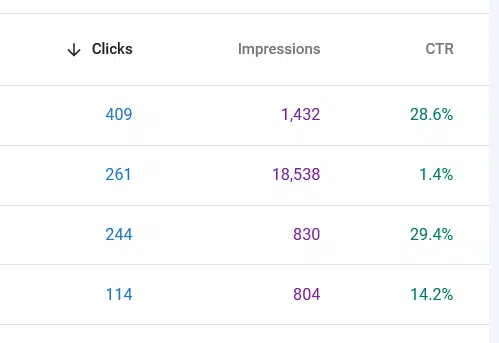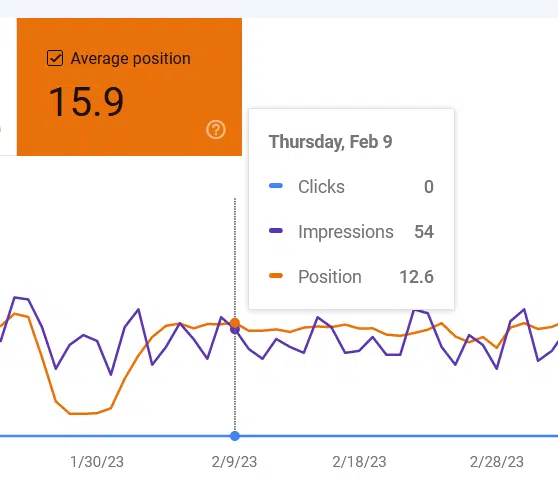Is click-through rate a valuable SEO metric?
While CTR is not a confirmed ranking factor, it is still useful for tracking organic search performance and improving SEO campaigns.
Several industry studies have asserted that CTR is a ranking factor – a claim that’s been ardently denied by many Googlers.
Whether it’s a direct ranking signal or not, CTR has its place in SEO.
This article explores why CTR matters in SEO, Google’s stance on the metric and how to use it right.
What does CTR mean for SEO?
CTR can mean many things depending on the context. In PPC campaigns, it is used as a metric to measure ad effectiveness.
When it comes to SEO, CTR refers to the percentage of people who click an organic or unpaid (Google) search result that leads to your website.
Essentially, if out of 100 searchers, five clicked through to your page from Google, then your CTR for that particular result is 5%.
Google conveniently shares the numbers with us on Google Search Console (GSC):

As usual, you have to take the numbers you see as approximations or relative numbers because Google withholds a significant percentage of search queries from us for privacy reasons.
Local results often make people disclose their whereabouts or other sensible data. Likewise, health and finance information may be too risky to share, so Google hides related keywords.
Measuring the impact of SEO: A look at metrics and KPIs
If CTR is not a confirmed ranking factor, is it still a useful KPI for tracking our SEO efforts? Or is it a vanity metric for showing off?
Many SEOs still rely on metrics that don’t really provide actionable insights, including rankings, traffic and engagement.
They are not completely useless, but by themselves and without context, these metrics won’t make sense.
Rankings differ depending on who searches from where based on search history and location and may be pointless with the wrong user intent.
Traffic can be completely irrelevant or downright harmful. Thousands of people looking for the wrong thing you don’t even offer only cause server load!
Engagement can be the wrong kind of engagement. When people are angry and write comments, it might look good as a number.
Satisfied visitors typically write fewer comments. Complaining happens much more often than expressing gratitude.
I believe CTR is a useful SEO metric. It lets you see how many people are clicking through and also how many are not. Then you need to find out why.
Does Google use CTR as a ranking factor?
Some SEO experts argue that Google can’t rely on links anymore as they are “gamed” easily. What else would be a useful metric they thought?
Well, given all the websites using Google Analytics and Search Console, Google has a wealth of user experience data. Some even point out that Google Chrome also collects such information.
For example, they can see whether visitors came, puked and ran away after clicking your website (thanks to bounce rate as measured by Google Analytics). They could also see who clicked through in the first place.
So these SEO experts concluded that such metrics might be a perfect ranking signal to use for Google along backlinks. Yet, there’s no reliable way to find out.
Then, some resorted to “correlation studies.”
They tried to look at the top-ranking content, analyze it and then, based on that analysis, reverse-engineer the algorithmic ranking signals.
A famous and somewhat shortsighted correlation has been widely spread ever since – content length.
The correlation studies showed that most top-ranking content was much longer that its lower-ranking counterparts.
Does it mean that just by writing 3000 words of fluff, you can outrank 1,000 words of expertly written, highly specific content? Most likely not.
It just means that the existing articles are probably expertly written and comprehensive. Note that this was before AI became a major part of ranking algorithms.
Today, search engines can use highly complex “machine learning” and artificial intelligence to determine the quality of websites and have to rely less on indirect metrics.
So correlation studies have indicated that well-ranking pages also have a higher CTR.
Does it mean that Google uses CTR as a ranking signal? Well, no. It’s possible but not proof.
As we know from science, correlation is not causation.
Just because you sneezed on a sunny day does not mean that the sun caused the sneezing.
Let’s take a closer look at some popular correlation studies below.
What do correlation studies say about CTR’s impact?
I remember at least three widely read correlation studies that looked at user experience factors like CTR (among others).
They suggested that indeed there is a significant correlation between website usage or click-throughs from search results and increased rankings.
- One such notable survey was done by Larry Kim of (then) WordStream back in 2016. The data set was relatively small but seemed to show some visible impact.
- Another CTR study was conducted by the German SEO tool vendor Sistrix in 2020. This time no claims on CTR being a ranking factor have been made despite a very large data set (probably the largest to date).
- The Semrush team also looked at many search queries in 2017, the respective (UX) signals and related rankings. They have found a strong correlation between “direct website visits” and top Google rankings.
The Semrush study stirred a lot of controversy for its bold claim that “direct traffic is the top ranking factor these days.” They did not specifically refer to CTR, though.
What does Google say about CTR as a ranking factor?
After word about these study results spread far and wide, it led to some weird tricks to fool Google into believing that results were clicked.
Huge click farms were used in Asia (e.g., mainland China) to simulate clicks by setting up a vast amount of hardware (thousands of smartphones or computers).
These click fraud machines were made to fake all kinds of online metrics, such as ad clicks, social media engagement and app downloads.
Google spokespeople repeatedly and vehemently deny that there is some impact or ranking signal related to CTR or other so-called UX factors.
Most strikingly, John Mueller stated in 2021:
“If CTR were what drove search rankings, the results would be all click-bait. I don’t see that happening.”
Whether you believe Mueller or not, it is improbable that CTR is an important ranking signal as it’s too easy to fool both by using click farms and by creating clickbait.
Last but not least, click studies have always shown that the results already on top get clicked the most. This would create a self-fulfilling prophecy and a closed loop in case Google uses CTR to determine rankings.
Position 1 results get the highest CTR, and thus Google would have to put the results that are already ranking on top higher than those shown below.
So unless Google created a rather complex algorithm to reduce the impact of top rankings on CTR (which differs based on numerous factors like location, industry, SERP features etc.), it would not make sense.
How to use CTR to improve your SEO
TL;DR: Although CTR is likely not a significant ranking signal and may be a bit of a vanity metric without context, it is also quite useful. (Otherwise, I wouldn’t go to such great lengths to write about it!)
So how can organic CTR benefit your SEO efforts?
Use CTR for discovering low-hanging fruit: You have many impressions but no clicks (low CTR)? Bingo! That might be a page that is almost ranking for a keyword.

You can find keyword combinations that just need a nudge to finally capitalize on existing visibility and get some clicks.
Use CTR to locate off-topic or irrelevant pages: So you have a high CTR but no conversions? There may be some mismatch between search query or user intent and the actual page or its content.
You may even rank high for a lucrative transactional query, but you waste people’s time and energy when there is nothing to buy (think out-of-stock products).
Use CTR to find highly valuable long-tail queries: So some more obscure three-word keyphrase has just three searches but 100% CTR? Whoa!
Let’s take a closer look, maybe there are even more similar long tail keyword combinations possible on the same page?
Just consider this screenshot from my blog’s GSC:

Yes, CTR can be a valuable SEO metric beyond mere vanity, regardless of whether it is a ranking factor.





